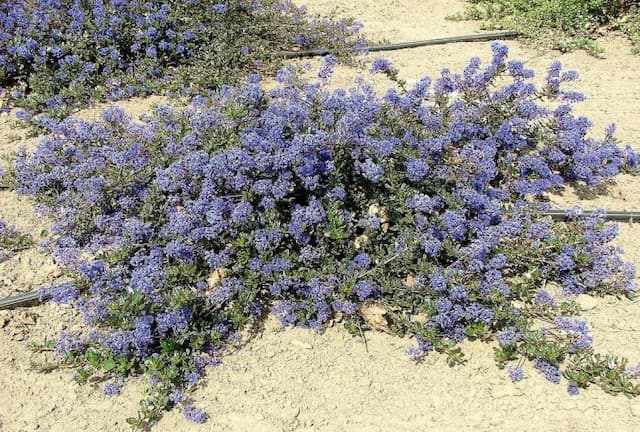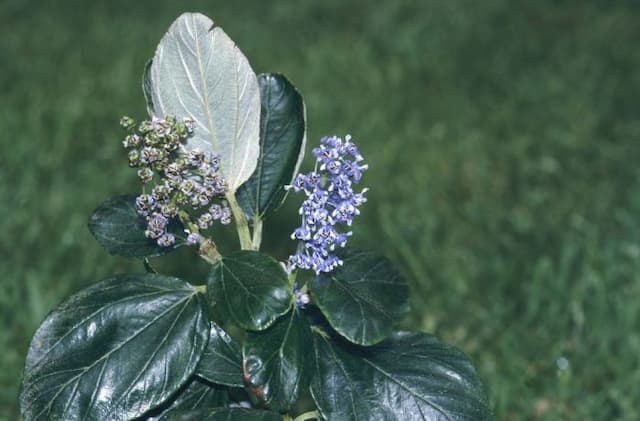Ceanothus 'Italian Skies'

ABOUT
Ceanothus 'Italian Skies' is a striking flowering shrub renowned for its vivid display of blossoms. This plant features clusters of radiant, deep blue flowers that come together in a frothy, cloud-like mass, creating a stunning visual impact during its blooming season. The blossoms are small, yet they are so densely packed that they deliver a bold splash of color in the garden. The foliage of 'Italian Skies' consists of small, glossy green leaves which provide a perfect backdrop to the bright flowers. These leaves are oval-shaped and possess a rich, verdant hue that remains attractive even when the shrub is not in flower. The overall form of Ceanothus 'Italian Skies' is rounded and bushy, creating a dense and lush appearance. When not in bloom, the foliage alone provides texture and color to the garden. Often popular for providing year-round interest, 'Italian Skies' becomes a focal point when adorned with its signature blue flowers which can attract pollinators like bees and butterflies, adding not just visuals but also contributing to the biodiversity of the area.
About this plant
 Names
NamesFamily
Rhamnaceae.
Synonyms
California Lilac, Blueblossom.
Common names
Ceanothus 'Italian Skies'.
 Toxicity
ToxicityTo humans
The California lilac 'Italian Skies' is not generally considered toxic to humans. There are no well-documented cases of poisoning from ingestion of this plant. Consequently, if it were to be ingested, it is unlikely to cause significant harm or symptoms of poisoning.
To pets
Similarly, California lilac 'Italian Skies' is not commonly known to be toxic to pets. It should still be noted that the consumption of any non-food plants can potentially cause gastrointestinal upset in animals due to the novel and indigestible nature of many plant materials. Therefore, while there are no specific toxic effects expected, ingestion of large amounts might lead to symptoms such as vomiting or diarrhea in some pets.
 Characteristics
CharacteristicsLife cycle
Perennials
Foliage type
Evergreen
Color of leaves
Green
Flower color
Blue
Height
6 feet (1.83 meters)
Spread
6 feet (1.83 meters)
Plant type
Shrub
Hardiness zones
7
Native area
North America
Benefits
 General Benefits
General Benefits- Attracts Pollinators: Ceanothus 'Italian Skies' is known for attracting bees and butterflies, which are essential for the pollination of many other plants.
- Drought Tolerance: Once established, this California lilac variety is quite drought-resistant, making it suitable for xeriscaping and water-wise gardens.
- Low Maintenance: It generally requires minimal care once established, which is ideal for gardeners looking for plants that do not require constant attention.
- Fast Growth: Ceanothus 'Italian Skies' grows relatively quickly, providing a rapid green filler or becoming a substantial feature in the garden in a short time.
- Erosion Control: This plant's root system helps stabilize slopes and hillsides, preventing soil erosion in such areas.
- Long Blooming Period: The California lilac boasts a long flowering season in spring, providing vibrant blue color over an extended period.
- Evergreen Foliage: It retains its foliage year-round, offering continuous visual interest and structure to the garden.
- Habitat Support: Offers shelter and food to various fauna like birds and beneficial insects, thereby supporting local biodiversity.
- Ornamental Value: With its striking blue flowers and glossy green foliage, Ceanothus 'Italian Skies' adds aesthetic value to landscapes and gardens.
- Deer Resistant: It is regarded as fairly resistant to deer, which can be particularly beneficial in areas where deer predation is a problem for gardeners.
 Medical Properties
Medical PropertiesThis plant is not used for medical purposes.
 Air-purifying Qualities
Air-purifying QualitiesThis plant is not specifically known for air purifying qualities.
 Other Uses
Other Uses- Dye Production: The leaves and blossoms of the California Lilac can be used to create natural dyes for fabrics.
- Fragrance Extraction: The flowers of the California Lilac are sometimes used in perfumery for their sweet and delicate scent.
- Decorative Branches: The woody stems and branches of the California Lilac can be harvested and used in floral arrangements or as decorative pieces in landscaping.
- Erosion Control: California Lilac's robust root system makes it ideal for stabilizing slopes and preventing soil erosion in hilly areas.
- Nectar Source for Bees: The flowers of the California Lilac are a rich source of nectar, attracting bees and helping in the pollination of neighbouring plants.
- Wildlife Habitat: The dense foliage of the California Lilac provides shelter and nesting sites for various birds and small mammals.
- Cooking: Though not commonly known, some parts of the California Lilac may be used as a flavoring agent or garnish in certain culinary traditions. Caution should be exercised as parts of the plant might be toxic if not prepared correctly.
- Photography Backdrops: The vibrant blue-violet flowers of the California Lilac make for an attractive backdrop in garden photography.
- Education and Research: The plant can be used in educational settings to demonstrate plant growth, care, and pruning techniques.
- Mulch Material: After pruning, the leaves and branches of the California Lilac can be shredded to create mulch which helps in retaining soil moisture and suppressing weeds.
Interesting Facts
 Feng Shui
Feng ShuiThe California lilac is not used in Feng Shui practice.
 Zodiac Sign Compitability
Zodiac Sign CompitabilityThe California lilac is not used in astrology practice.
 Plant Symbolism
Plant Symbolism- Resilience: The Ceanothus 'Italian Skies', or California lilac, is known for its ability to thrive in poor, dry soils, symbolizing the ability to endure and prosper in challenging conditions.
- Hope: With its bright blue flowers, the California lilac is often associated with hope and optimism, representing the expectation of positive outcomes and new beginnings.
- Patriotism: The California lilac's vibrant blue hue is reminiscent of the blue found in the United States flag, invoking a sense of national pride and loyalty.
- Beauty: The lush blooms and fragrance of the California lilac symbolize natural beauty and aesthetic appreciation, highlighting the pleasures of the senses.
- Abundance: Often profuse in its flowering, the California lilac can symbolize abundance and generosity, with its dense clusters of blossoms representing fullness and richness.
 Water
WaterCalifornia lilac, or Ceanothus 'Italian Skies', prefers well-draining soil and does not require frequent watering once established. Generally, water deeply but infrequently, aiming for about once every one to two weeks during the dry season, depending on your climate and soil drainage. Give the plant approximately one gallon of water per five feet of shrub height each time you water, ensuring that the soil is moist but not soggy. During winter or in cooler climates, you can reduce watering as the plant will require less moisture. Always check the top few inches of soil for dryness before watering again to avoid overwatering
 Light
LightCalifornia lilac thrives best in full sunlight, which means at least 6 to 8 hours of direct sunlight each day. It's ideal for a spot in the garden that receives unfiltered daylight throughout the day. While it can tolerate partial shade, too much shade can impede flowering and can cause the plant to become leggy
 Temperature
TemperatureCalifornia lilac can endure a wide range of temperatures but prefers a moderate climate. It can survive minimum winter temperatures down to about 10 degrees Fahrenheit but may suffer damage below this point. The ideal temperatures for this plant are between 55 and 75 degrees Fahrenheit. In summer, the plant can handle higher temperatures, up to 100 degrees Fahrenheit, as long as other conditions such as moisture and soil are attended to
 Pruning
PruningPrune California lilac to maintain shape and promote vigorous growth. It's best to prune after blooming in late spring or early summer, as the plant blooms on the previous year's growth. Remove any dead or crossed branches to improve air circulation. Thinning out older stems every few years can invigorate the plant and encourage a flush of new growth
 Cleaning
CleaningAs needed
 Soil
SoilCalifornia Lilac ('Italian Skies') thrives in well-draining soil with a pH between 6.0 and 8.0. A suitable soil mix could consist of equal parts garden soil, sand, and organic compost to ensure good drainage and fertility. Avoid heavy, clay soils, as these can lead to root rot in this drought-tolerant species.
 Repotting
RepottingCalifornia Lilacs, including the 'Italian Skies' variety, typically do not require frequent repotting and can suffer from overhandling. They should only be repotted if they have outgrown their current container, which is unlikely to occur often as they prefer to be slightly root-bound.
 Humidity & Misting
Humidity & MistingCalifornia Lilac ('Italian Skies') prefers low to average humidity levels, typical of its native Mediterranean climate. It is well-suited to dry conditions and does not require high humidity to thrive.
 Suitable locations
Suitable locationsIndoor
Place in bright, indirect light and avoid overwatering.
Outdoor
Plant in full sun, well-drained soil, and water sparingly.
Hardiness zone
8-10 USDA
 Life cycle
Life cycleCeanothus 'Italian Skies'—commonly known as the Italian Skies California Lilac—begins its life as a seed, which after stratification (cold treatment), germinates in the spring. Upon sprouting, the seedling grows rapidly, thanks to its vigorous root system, and by the first year, it may start to form a woody base, characteristic of this evergreen shrub. Over the next few years, the plant matures and develops dense foliage with glossy green leaves and begins its flowering stage, typically in late spring to early summer, showcasing clusters of intense blue flowers. It reaches full maturity in several years and can bloom every year, given proper care and climate conditions. After its bloom, the flowers develop into small, hard seed capsules, which when mature, release seeds to start a new generation. The Italian Skies ceanothus has a moderate lifespan, often living approximately 10-15 years or longer if it is well-maintained and free from pests or diseases that can affect its longevity.
 Propogation
PropogationPropogation time
Spring-Early Summer
Propogation: Ceanothus 'Italian Skies', commonly known as California lilac, is most effectively propagated through semi-hardwood cuttings during summer. Choose a healthy section of stem from the current year's growth that has begun to mature but is not yet completely woody. Cut a length of 4 to 6 inches (10 to 15 cm), ensuring it contains several leaf nodes. Remove the lower leaves and dip the cutting end into a rooting hormone powder to increase the chance of successful rooting. Plant the cutting into a pot filled with a well-drained propagation medium, such as a mix of half peat and half perlite. Keep the medium moist but not waterlogged and place the pot in a warm area with bright, indirect sunlight. Rooting usually occurs in several weeks, after which the new plants can be gradually acclimatized to outdoor conditions and transplanted into the garden.









